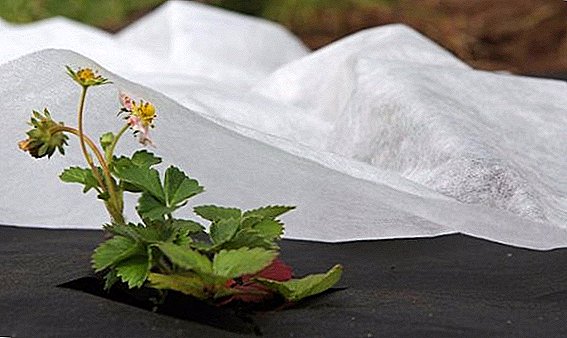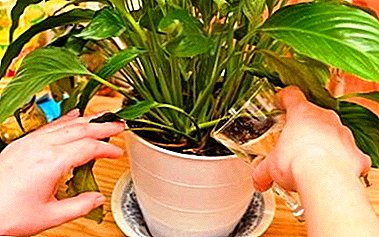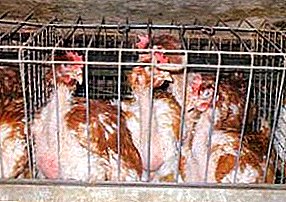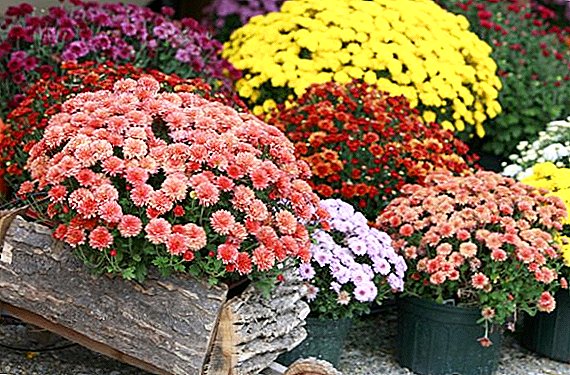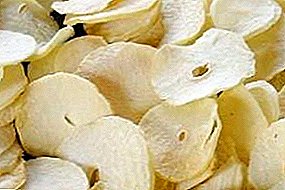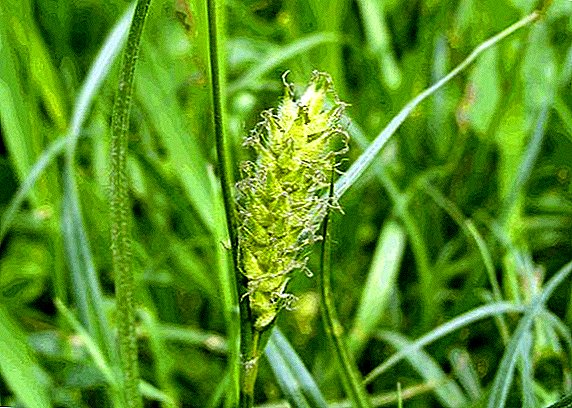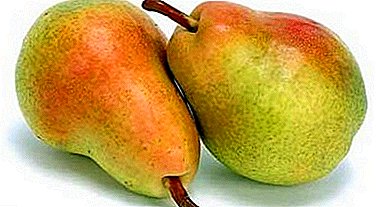
Begonia is probably the most popular home plant now, and earlier it could be found in any house. With all its unpretentiousness, this flower can please you all summer and autumn. About ampelous begonia, growing it in pots and caring at home and lead on.
Ampelous begonia
Perennial flowering plant grows equally well in the open and in the green field.
Did you know? Begonia came to Europe at the beginning of the 18th century. At first, only ornamental deciduous species were cultivated. Later, begonias that grew for the sake of flowers came into fashion.It has long shoots on which bright leaves grow. Flowers are arranged in cascades. The colors are various - red, pink, white. Flowers begonias are divided into male and female. It is male flowers that make begonia so beautiful. One flower blooms about 10 days. Flowering is very long - 4-5 months, and with proper care and longer.

Growing conditions
The most important thing for ampelous begonia is to provide favorable conditions for planting and care.
Lighting and location
Begonia loves sunshine very much. But direct light can damage a plant, so choose a place where there is a lot of light, but it is diffused. Best of all, if the flower is in the light before 11 and after 15 hours. In this case, you can easily withstand the temperature regime - 20-25 ° C. This temperature is optimal for the growth and flowering of begonias.
Plant substrate
For these flowers, it is better to choose a neutral or slightly acidic soil. Acid soils they can not tolerate. You can buy a ready-made substrate for begonias or prepare it yourself. To do this, you just need to mix the sheet, sod land with sand in the ratio of 4: 1: 1.
Any soil (purchased or not) must be disinfected. This will protect the seeds and young plants from disease and mold.
Did you know? Ampelnye can be both indoor and outdoor plants. Recently, not only herbs but also some bushes have been grown as ampelous.This can be done by several methods:
- Freeze - hold the soil at sub-zero temperatures until it freezes.
- Warming up - pour boiling water over the soil to kill bacteria.
- Pour a weak solution of potassium permanganate.
- Steaming - put the primer in the water bath.

Reproduction and planting tubers
Any plant has several breeding methods. Begonia is best planted with tubers.
Tuber selection
The most important thing for an ampelous begonia when growing from tubers at home is a careful selection of planting material. Therefore, we start with the preparation of tubers.
Tubers should be small, about 3-4 cm in diameter. They must be clean, without mold, without earth and hilly. These bumps are the buds that will grow. A good tuber has up to 7 such buds.
Preparation of planting material
For germination, put the tubers in a tray or on a damp cloth, leave in a bright room. We need to wait for the appearance of the roots - now the flower is ready for planting.
Indoor plants such as Kalanchoe pinnate, Clerodendrum, Piperomy, Howea, Kalanchoe Kalandiva, Ficus Microcarp, Kalanchoe Degremona, Tsiperus, strawberry tree and Haworthia will inspire you and improve your quality of life.
Landing
Begonia pot should be shallow and wide, with holes to remove excess moisture. First, drainage is poured into the pot, then the prepared substrate.
Tubers are planted bulge down. The top should not fall asleep, it should be no less than 2 cm below the edge of the pot. Watering the tuber cannot be categorically - watering is carried out around the tuber.
After the first three or four leaves, you can fall asleep tuber.
Growing begonias from seed
A more complicated way to grow ampelous begonia is growing from seeds at home.
Sowing scheme
Flower seeds are very small: there are more than 60 thousand seeds per gram. Therefore, it is better to use granulated seeds. Such granules have a nutrient shell, high germination and are convenient for spot sowing in pots or peat tablets.
To do this, prepare the tablets - place them in a container and wet them with water. When tablets are soaked, put one granule in each. Moisten them lightly with water (preferably from a spray bottle) and cover with a wrap or plastic cup to create a greenhouse effect. Watering through the pallet. This is the only necessary procedure at this stage.
Ordinary seeds are suitable for sowing in special seed boxes. Thus, even Bolivian begonia can be grown from seeds.
First prepare the tanks - pour stones for drainage, moisten the soil. All this needs to be done the day before sowing. Now the seeds need to be evenly distributed on top of the soil - they are not required to fall asleep. Close the container with glass or plastic to turn it into a greenhouse.
Maintain containers with seeds at a temperature of 25 ° C. In this case, the seedlings will appear within two to three weeks.
Seedling care
Care of young shoots consists in regular watering, hardening and providing access to light.
Water the seedlings need the lower way: the best through the pan. Be sure to follow the soil moisture - drying out will have a detrimental effect on seedlings. 
Important! Top watering is strictly prohibited.Plants need a lot of light, but the direct rays of the sun are harmful to them. Try to provide regular access to diffused light. In the winter months, when the light day is short, you need to create a corner with artificial lighting, gradually replacing it with a natural one.
Be sure to start hardening the seedlings. To do this, remove the box cover for 10-15 minutes every day, gradually increasing the time and degree of opening of the greenhouse.
Reproduction by cuttings
The plant propagates quickly and easily by cuttings.
To do this, prepare the shoots with a length of 8-10 cm, clean them and dry. This cutting is placed in a vessel with room temperature water. After some time, the roots will appear. When the cut starts to rot, the stalk is pulled out of the water, dried, cleaned the damaged place and put back into clean water. When the roots grow to 2 cm, the plant is ready to root in the pot.
How to care for culture
So, we have grown young plants. Now let's figure out how to care for begonia.

Watering
The plant needs special watering: the flower tubers can not be watered. Therefore, watering should be done either on the edge of the pot or in the pan.
Watering needs moderate. It is important not to cross the line - the soil should not dry out and should not be very wet.
Begonia in the care of the winter in watering needs very rarely.
Top dressing
For a stable and steady growth, flowers need additional feeding.
For a set of green mass, use nitrogen fertilizers (urea). When the flowering time begins, nitrogen can be reduced or removed, and phosphorus and potassium can be used. 
It is also possible to use fertilizers for flowers with microelements - for example, Kemira Lux (or similar).
Important! Organic fertilizers can be used no more than twice a year.
Removing faded colors
The flowering of begonias takes a long time, so the removal of faded flowers is simply necessary - this way you clear the place for new ones. And apparently the plant with faded flowers looks ugly.
Every day, check the plant and remove dried flowers with your hands.
Treatment and prevention of diseases
Begonias can be affected by powdery mildew. In this case, you need to remove the affected sheets, and spray the plant itself with a fungicide (for example, you can use Topaz).
If you do not follow the rules of courtship, the flower may begin to lose leaves and fade. Reconsider the frequency of watering and see if the plant gets enough light.
In dry air indoor areas, a red spider mite may appear. About its appearance will say yellow spots on the leaves. If such a nuisance has happened - treat all the flowers with an insecticide ("Bi-58 New").
Begonias are very beautiful flowers, suitable for amulet cultivation. Take care of them correctly, and they will bloom all summer in your home.



